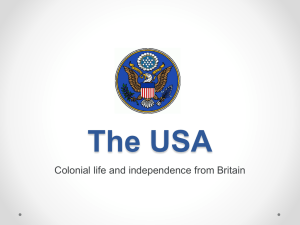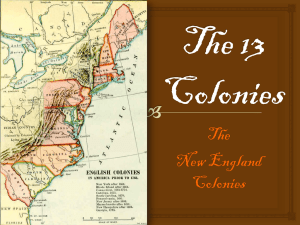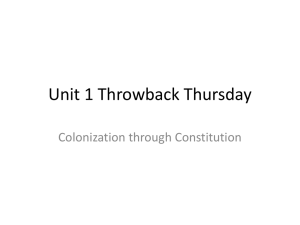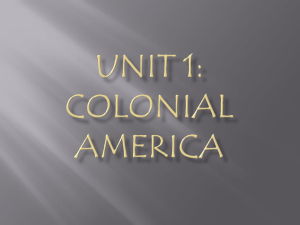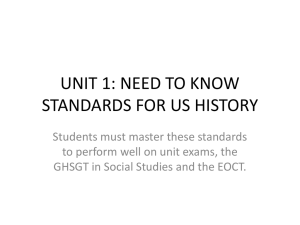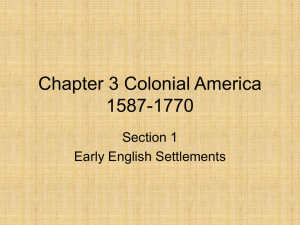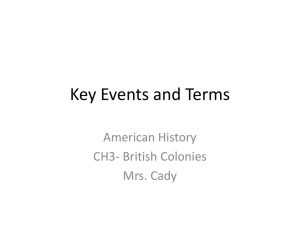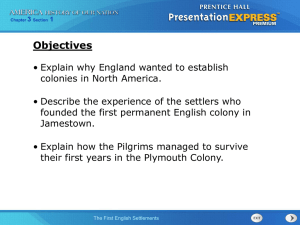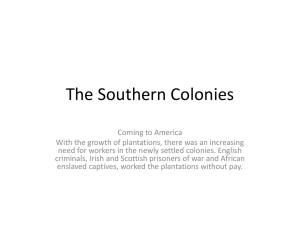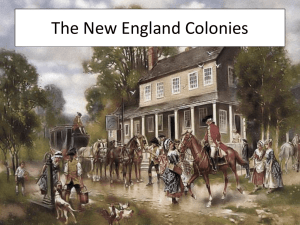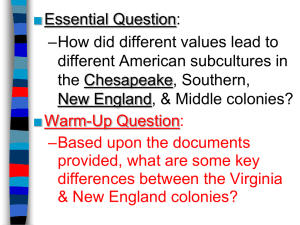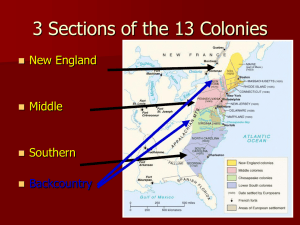01 Early colonisatio..
advertisement
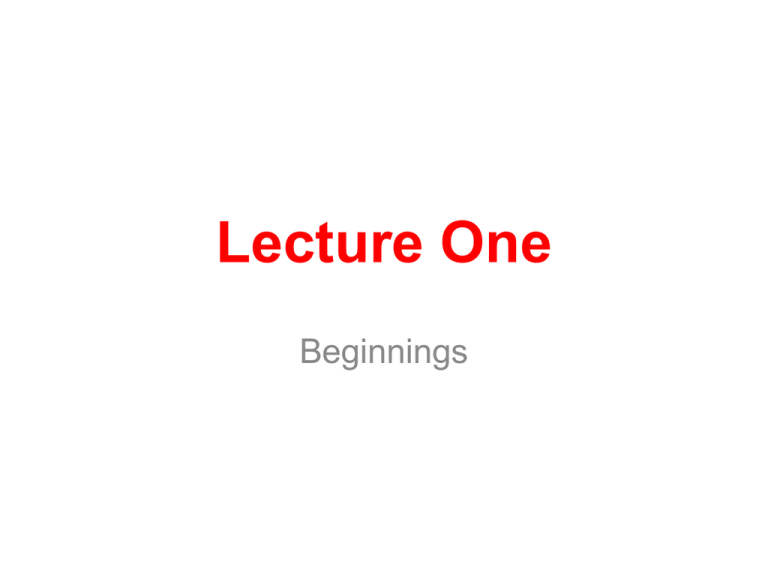
Lecture One Beginnings The United States of America 1. History and the principles of the political system 2. American economy 3. American culture and society The Beginnings of America Before the formation of the United States How America influenced what we eat? “The Discovery” • 12 October 1492 – Christopher Columbus reaches the island he names San Salvador (Holy Savior) – he thinks he is in India. • Inhabitants of the land became “Indians” (today they are usually called Native Americans). Columbus takes new land Why America is called America? • Italian explorer from Florence, Amerigo Vespucci described his journeys he made in the 1490s • He suggested the existence of the new land to the east of Europe The Beginnings of English Expansion • Sir Walter Raleigh |ˈrɑːli|asked Queen Elizabeth to start a colony in the new world • He reached Roanoke Island in 1584 • He named the entire region Virginia (from Virgin Queen = Elizabeth I). Roanoke Island 1st settlement • Complete failure! • Most of the people died of hunger and attacks from Indians The Second time • In 1587, Raleigh sent colonists a second time with wives and children • John White was the colony’s governor • John White’s granddaughter, Virginia Dare was born 1 month after they arrived in the USA on August 18 the first English baby born in the USA. The Lost Colony • John White returns to England for supplies. • He returns in August 1590 to find no colonists on Roanoke Island. • On one of the trees they find a caption “CROATOAN” (it was the name of an island nearby as well as the name of the Native Americans living in the area. The Virginia Company • In 1606, King James I gives permission to the Virginia Company of London to try a colony. • On May 14, 1607, the settlers began building the first English permanent settlement on the James River in Virginia. • Jamestown was named after the King James I (and Virginia was named after the Virgin Queen of England). Jamestown, Virginia Jamestown and Roanoke Island John Smith • In 1608, John Smith takes over leadership of the Jamestown colony. • Problems: hunger, disease, Indians. • January 1608, only 38 of the colonists remained alive. • Colony survives because: 1. “No work, no eat” 2. Bargaining for food with the Powhatan Indians. Pocahontas • Johns Smith fights with Powhatan Indians. • He is taken prisoner • He was saved by Pocahontas, a Powhatan Native American. Tobacco • Englishman John Rolfe in 1614 found a way to harvest tobacco. • He also married Pocahontas in 1614 and thus created peace with the Powhatan Native Americans for 8 years. Princess Pocahontas • Pocahontas, character of popular culture. • Brought to England, is baptized and dies young of smallpox a disease she did not know. JOHNJohn ROLFE RolfeAND POCAHONTAS early 1850s, J. W. Glass Pocohantas Government and slavery • In 1619, the House of Burgesses begins a tradition of self government in America. • In 1619, a Dutch ship brings the first Africans to Jamestown – beginning of slavery. • In 1619, The Virginia Company of London sends 90 women to Jamestowne as wives for the settlers (120 pounds of tobacco for a wife) • 22 March 1622 Powhatan uprising – one fourth of the colonists killed. • In 1624, King James I revokes the Virginia Company’s charter and Jamestowne becomes a Royal colony (a colony run by a king and his appointed governor). English Colonisation of America Religion, Business and Politics After Jamestown • Jamestown colonists went to live in America because they wanted to get rich. They were sent there by businessmen (Virginia Company). • The second important group of colonists came to live in America because they wanted religious freedom. Religious conflicts • Protestant dissenters: the Puritans – influenced by the teachings of John Calvin. • Puritans – because they wanted to keep the English Church (and English people) “pure”. • They did not recognize bishops, did not want colourful churches and sumptuous masses. • James I – conflict with the Puritans • Puritans decide to emigrate – first to Holland then to America. 1620: The Pilgrim Fathers • 16 September 1620, Pilgrims leave England (Plymouth). • They are called Pilgrims – because they went there for religious purposes. The Mayflower Compact • On a ship (called Mayflower) to America – signed the agreement, now called the Mayflower Compact. • Agreement: to work together for the common good. The Mayflower Mayflower Compact • They set up the government “the civil body politic”. • Agreed to make “just and equal laws”. • One of the first documents in the history of American democracy. Mayflower Compact 9 November 1620 • They land in Massachusetts (land named after Native American people living there). • The first settlement is called Plymouth. • The land is called New England. The Pilgrim Fathers land in America Difficult life of the early colonists • Problems similar to the problems of the previous settlers: hunger and diseases. • Half of the colonists (50 out of more than 100) die during the first winter. • The rest saved by native Americans who helped them and showed new food: corn, pumpkin, turkey. Thanksgiving • Every third Thursday in November. • Thanks to God for good harvest after one year in America, in November 1621. The Great Migration • Ten years later, in 1630, a second much larger group came to America, around 1000 people. • They established Boston. • Between 1630-1640, around 20 000 colonists came to America. • In 1661 – Plymouth Colony + Boston Colony = Massachusetts. Puritan Values • Puritans had a lasting influence on American culture. • Very idealistic: (“city on the hill”, “the New Jerusalem”). • But not very tolerant: duty of the government to make people obey God’s law, e.g. – going to the church compulsory – drinking, adultery and long hair in men punished American Utopia • America: model for other nations (doctrine of American exceptionalism). • Hard work and self moderation. • Education for all children. • Self-government. Separation of the Church and State • Some of the colonists disagreed with the harsh laws that Puritan leaders imposed. • Under the leadership of Roger Williams (preacher from Salem) they started the colony of Rhode Island (religious freedom, separation of the church and state). • The other group of dissenters founded New Hampshire (separate colony since 1679). Pennsylvania • A religious group called The Society of Friends (Quakers) were against all wars (pacifists) and believed men and women are equal (so for example they can be priests). • 1681 – William Penn, a Quaker received the permission from Charles II to create his own colony – Pennsylvania. • He invited colonists (also from other countries) promising religious freedom and tolerance. Formation of Other Colonies • 1626 – Colonists form Holland build New Amsterdam. In 1664 captured by the English and renamed New York. • 1634 – Maryland, a colony where Catholics could settle. • In 1681 William Penn – received a permission to start a colony in America: Pennsylvania. • 1691 – supporters of Charles II created North Carolina. • The last English colony was Georgia – settled in 1733. 13 English Colonies Growth of the Colonies • Three major cities Philadelphia, New York and Boston. • In 1770 – Philadelphia, the biggest American city with the population of 28 000. Philadelphia English Colonies: 3 groups • New England colonies – mainly Puritans. • Middle Colonies (Pennsylvania) – greater religious tolerance and diversity; people not only from England but also Germany, Sweden and Holland. • Southern Colonies (Virginia, Carolinas, Georgia) – large plantations with slaves brought from Africa. Westward expansion • After 1733 – colonists start to expand to the west of the American continent looking for new land and new opportunities • The area where European settlement came to an end and the forest lands of the Amerindians began, was called the frontier (or later the Wild West). • “Frontier way of life”: independence, self-reliance, toughness. French and Indian War • French colonies in Northern America: 1. North: Quebec and Montreal. 2. South: Louisiana (after Luis XIV) and New Orleans. • 1756 - the war with France starts. • 1763 – France gives up its claims to American territories. Conflicts with England • Costly war - new taxes on imports of sugar, coffee, textiles, and other goods. • Need to feed the English soldiers. • Limits on the expansion to the West. • New taxes and regulations. • Colonists' fear: government too powerful: “No taxation without representation” The American Revolution: 1775 • Fighting between British soldiers and the American Patriots began April 19,1775, at Lexington and Concorde, Massachusetts. • The war’s last major battle was at Yorktown, Virginia in September and October 1781. • Britain formally recognized America independence with the signing of the treaty of Paris on September 3, 1783. Events leading up to the revolution 1. The Proclamation of 1763 – England’s King George forbid colonist to settle west of the Appalachian Mountains. 2. The Sugar Act of 1764 – tax on sugar from outside the British Empire. 3. The Stamp Act of 1765 – required colonist to pay for tax stamps on newspapers, and various legal documents. Parliament abolished the Act in 1766. 4. The Townshend Acts of 1767 placed a duty on imported goods including glass, lead, paint, and paper. Americans responded by not buying British goods. Boston Tea Party • On December 16, 1773, Samuel Adams led patriots, disguised as Indians, on a raid of British ships docked in Boston’s harbor. They dumped the cargoes of tea overboard. This was later called the Boston Tea Party. The Intolerable Acts of 1774 • – were Britain’s response to the Boston Tea Party. One act closed Boston’s harbor until the colonists paid for the destroyed tea. Another took away nearly all power from Massachusetts’ legislature. Control of the colony was given to the newly appointed British governor, General Thomas Gage. The First Continental Congress • September 5 – October 26, 1774 • Attended by representatives from all the colonies except Georgia. • They met in Carpenter’s Hall in Philadelphia to protest the Intolerable Acts. • Decided to stop trade with Britain unless the Acts were abolished. • They also advised colonists to prepare for war. They agree to meet again in May 1775. The Forces • Britain had large numbers of well trained militia. Soldiers’ uniforms included bright red jackets: “redcoats”. • The colonies did not have a central government, army, or navy. • Each colony did have a small citizen army called the militia: ordinary people. Battles of the Revolutionary War • Lexington and Concord, Massachusetts 1775
